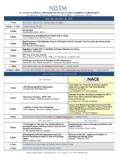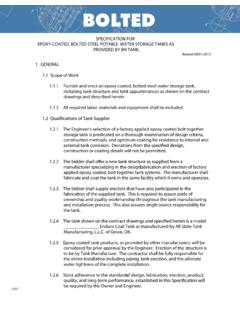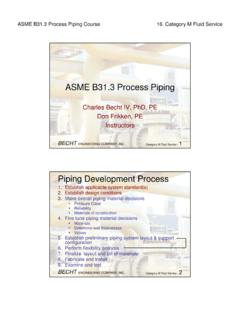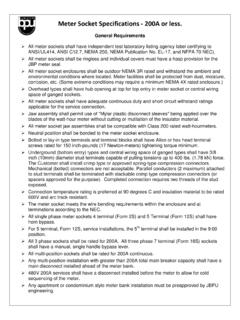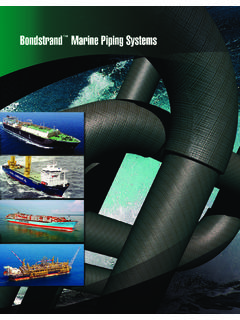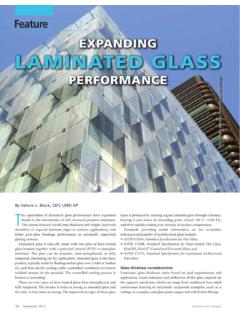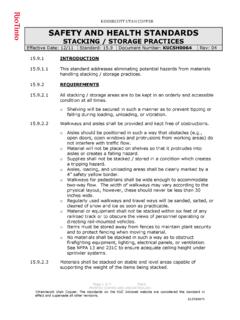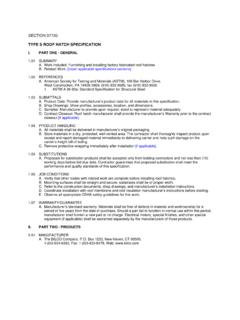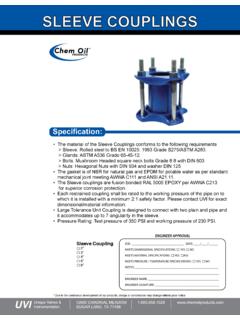Transcription of Update to Industry Grounding Standards - NISTM
1 Update to Industry Grounding Standards David L. Redman Senior R&D Engineer Matrix Service Inc. Outline Background on Grounding and Lightning API 650 Code requirements NFPA 780 Code API RP 2003 Code Working Document API RP 545. 09/11/2009 Grounding Standards 2. Background Metallic structures can have buildup of electrical energy and can also attract electrical energy from storms Electrical energy always takes the path of least resistance Presentation only addresses bonding requirements and suggested practices from applicable codes 09/11/2009 Grounding Standards 3.
2 Background (cont'd). Concerns with Above Ground Storage Tanks Open Top Tanks with Floating Roofs have the largest risk with fires from lightning strikes Sparks can be generated from gaps between seal shunts and shell No other path for electrical energy Cone Roof Tanks are generally the safest Welded tanks with fixed roofs have very few cases of fires from lightning strikes Biggest risk is with burn through from a lightning strike 09/11/2009 Grounding Standards 4. Codes Addressing Bonding for ASTs API 650 Above Ground Storage Tanks NFPA 780 Standard for Installation of Lightning Protection Systems API RP 2003 Protection Against Ignitions Arising Out of Static, Lightning, and Stray Currents 09/11/2009 Grounding Standards 5.
3 API 650 - ASTs For ALL Tanks Section states that if the Purchaser requires Grounding lugs then it is recommended to provide a minimum of 4 Grounding lugs, equally spaced at a maximum 100 ft spacing. Recently added Note: Tanks that rest directly on a foundation of soil, asphalt or concrete are inherently grounded for purposes of dissipation of electrostatic discharges. The addition of Grounding rods or similar devices will not reduce the hazard associated with electrostatic charges in the stored product. 09/11/2009 Grounding Standards 6. API 650 ASTs (cont'd). For Open Top Tanks with Floating Roofs Appendix C Section states that all conductive parts shall be grounded and to provide shunts on the uppermost seal Recently added All movable cover accessories (hatches, manholes, pressure relief devices, and other openings) on the external floating roof shall be electrically bonded to the external floating roof to prevent static electricity sparking when they are opened.
4 09/11/2009 Grounding Standards 7. API 650 ASTs (cont'd). For Open Top Tanks with Floating Roofs Appendix C Section covers rolling ladders and it was recently added Ladders shall be grounded to both the roof and the gauger's platform with at least an AWG 2/0, non-tangible cable. Cable shall be configured so that it will not freeze to adjacent surfaces in cold weather . 09/11/2009 Grounding Standards 8. API 650 ASTs (cont'd). For Fixed Cone Roof Tanks with Internal Floating Roofs Appendix H Section states that all conductive parts shall be grounded and to use either shunts or cable to ground the floating roof to the shell Recently added The choice of bonding devices shall be specified by the Purchaser on the Data Sheet, Line 32, considering strength, corrosion resistance, joint reliability, flexibility, and service life.
5 All movable cover accessories (hatches, manholes, pressure relief devices, and other openings) on the internal floating roof shall be electrically bonded to prevent static electricity sparking when they are opened. 09/11/2009 Grounding Standards 9. NFPA 780 Standard for the Installation of Lightning Protection Systems Section Aboveground Tanks at Atmospheric Pressure Containing Flammable Vapors or Liquids That Give Off Flammable Vapors Fixed Roof Tanks All joints shall be welded, riveted, or bolted All pipes shall be metallically connected at shell All vapor openings shall be closed or provided with flame protection Minimum thickness of roof plates is 3/16 inch Roof shall be welded, riveted, or bolted to shell 09/11/2009 Grounding Standards 10.
6 NFPA 780 Standard for the Installation of Lightning Protection Systems Section Cont'd Floating Roof Tanks Seals on Floating Roof (FR) shall be bonded to the shell by shunts (Type 302, 28 gauge, 2 inch wide stainless steel straps) at maximum 10 ft spacing All Metal Tanks All must be grounded by one of the following: (1) Tank connected without insulating joints to a grounded metallic piping system (2) Vertical cylindrical tank shall rest on earth or concrete and shall be at least 20 ft diameter OR rest on bituminous pavement and shall be at least 50 ft diameter (3) Tank shall be bonded to the ground by a minimum of two Grounding electrodes at 100 ft maximum spacing (4) Tanks with insulating membrane underneath for environmental or other reasons shall be grounded as in (3).
7 09/11/2009 Grounding Standards 11. NFPA 780 Standard for the Installation of Lightning Protection Systems Section , Table (A). Gives minimum cable sizes for Grounding 17 AWG for copper 14 AWG for aluminum 09/11/2009 Grounding Standards 12. API RP 2003 Protection Against Ignitions Arising Out of Static, Lightning, and Stray Currents Section Storage Tanks Recommended Operations Restrict flow rate to 3 ft/sec to reduce static buildup Keep fill pipe outlet near bottom to avoid splash filling Tanks built on grade-level foundations are inherently grounded Ground all gauging devices and gauge wells Mixers and jets should not break the fluid surface Floating roof shall be bonded to shell 09/11/2009 Grounding Standards 13.
8 API RP 2003 Protection Against Ignitions Arising Out of Static, Lightning, and Stray Currents Section Protection of Specific Equipment Against Lightning Section Fixed Roof Tanks All metal parts to be in electrical contact Keep all roof openings closed (such as gauge hatches). Ensure fixed roof has adequate thickness (no holes or excessively thinned areas). Use pressure vacuum vents (they provide backflash from exterior flames). Stop tank movements during electrical storms 09/11/2009 Grounding Standards 14. API RP 2003 Protection Against Ignitions Arising Out of Static, Lightning, and Stray Currents Section Protection of Specific Equipment Against Lightning Section Open Floating Roof Tanks Best protection against ignition are tight seals and properly designed shunts Shunts at maximum 10 ft spacing (2 inches wide X 28 gauge 302 SS material).
9 Shunts should have at least 2 inches clearance from top of shell for positive contact Pontoon covers to have mechanical hold downs Keep floating roof above landing position (especially during electrical storms). 09/11/2009 Grounding Standards 15. API RP 2003 Protection Against Ignitions Arising Out of Static, Lightning, and Stray Currents Section Protection of Specific Equipment Against Lightning Section Internal Floating Roof Tanks Floating roofs shall be electrically bonded to shell Shunts at maximum 10 ft spacing (2 inches wide X 28 gauge 302 SS material). Shunts should have at least 2 inches clearance from top of shell for positive contact Pontoon covers to have mechanical hold downs Keep floating roof above landing position (especially during electrical storms).
10 Provide adequate venting per API 650 Appendix H. 09/11/2009 Grounding Standards 16. Working Document API RP 545 Lightning Protection for Above Ground Storage Tanks Working Document being reviewed by API. Committees Main Conclusions from two Phases of testing Definite potential ignition hazards at shunt/shell interface for Open Top Floating Roof tanks. Sparking at shunts is inevitable, seal maintenance is important Severity of sparking can be reduced by use of earth cables from floating roof to shell OR by bonding via rolling ladder Immersed shunts may be a good solution to hazardous shunt sparking 09/11/2009 Grounding Standards 17.
